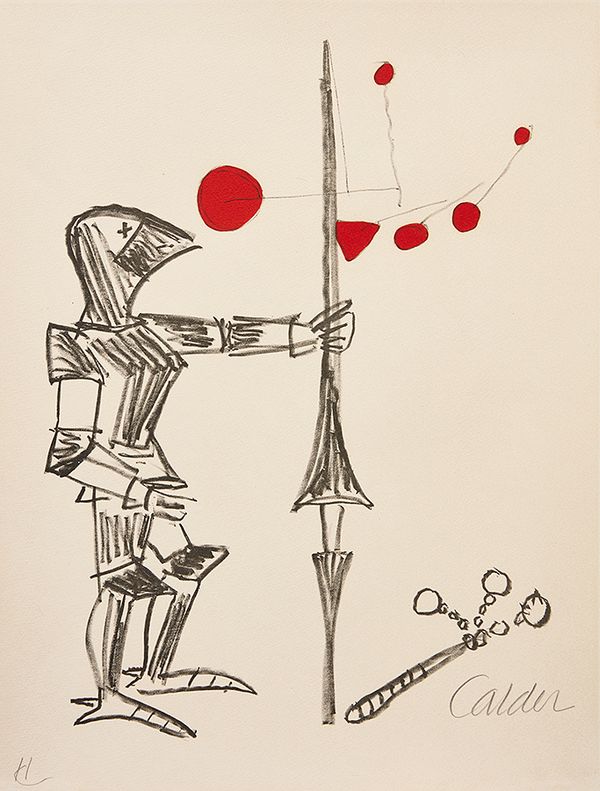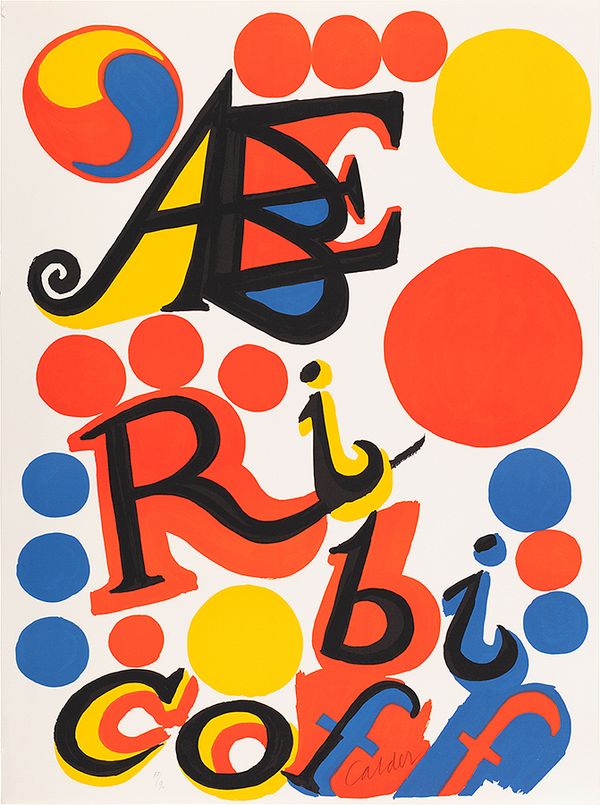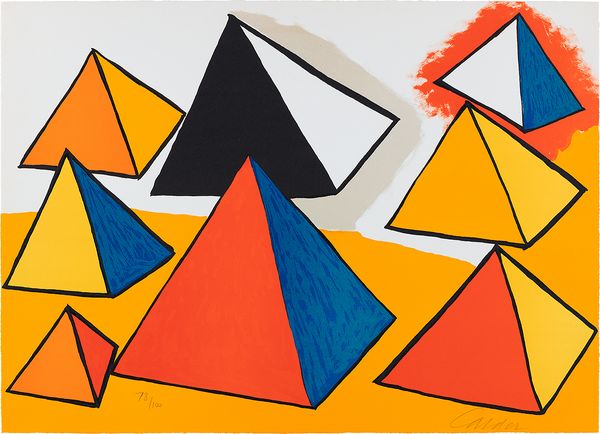Alexander Calder, Homage to Euclid (Composition IX), from La Mémorie élémentaire, 1976. Editions & Works on Paper New York.
An impressive 25 prints by the great American artist Alexander Calder are on offer in our upcoming Editions & Works on Paper auction in New York. Taken together, these prints attest to Calder’s long-term interest in the medium, his proficiency in a variety of printing techniques, and his exploration of numerous visual ideas.
Though most well-known for his three-dimensional works, a consideration of Calder’s printmaking offers a renewed understanding of his immediately recognizable practice. His prints can be seen to represent a sort of distillation of various formal and visual elements that are hallmarks of his sculptural work. In short, what we perhaps love most about Calder’s work — a masterful economy of line, shape, form, and color — is rendered in his printmaking with a purity that attests to his command of his own visual language.

Alexander Calder, Tapestry, 1975. Editions & Works on Paper New York.
Calder came from a long line of artists — both his father and grandfather were sculptors, and his mother was a portrait artist — yet his parents discouraged him from following their own path. Calder eventually decided to study mechanical engineering at Stevens Institute of Technology in Hoboken, New Jersey. It’s often remarked how his study of engineering aided his later large-scale sculptural work, but it’s perhaps not mentioned enough how it also would have taught him one of the engineer’s most important skillsets — draftsmanship.
Upon earning his engineering degree, Calder held various jobs in the field, including as a draftsman at the New York Edison Company. When he later went on to study at the Art Students’ League, it’s possible that many aspects of what he learned about drawing would not have been wholly new to Calder, as he would have had experience from a different perspective through his engineering coursework and practical experience. For instance, John Sloan, one of Calder’s instructors at the Art Students’ League, once wrote, “The mastery of an authoritative line is the thing that is back of Picasso and what distinguishes him from all the people who are pattering around after him.” The idea of the “authoritative line” holds a twofold meaning in this way. Given Calder’s engineering background, his draftsmanship training carried with it a formalized approach to linework, then set free from the confines of precision and recontextualized in the free-flowing nature of his art.

Alexander Calder, Le Noble chevalier (The Noble Knight), 1960. Editions & Works on Paper New York.
It was upon moving to Paris in 1926 and mingling with early 20th century avant-garde figures including Joan Miró, Fernand Léger, Piet Mondrian, and Marcel Duchamp, Calder first became acquainted with printmaking. Friendship with Stanley William Hayter also proved pivotal, as Hayter would go on to become one of the most influential printmakers of the 20th century and Hayter’s Atelier 17 would collaborate with Calder in creating his early etched work.
The best of Calder’s prints have a tremendous sense of vitality, combining bold shapes and broad sections of color in dynamic, intuitive ways.
—The New York Times
Calder’s prints often employ black lines and primary colors. The visual subject matter included geometric lines, spirals, and flattened biomorphic shapes, including pyramids. While many of his prints appear as abstract, Calder also incorporated symbols of people, plants, and animals.
Calder’s production of prints would go on to expand as his fame and global reputation grew in the 1940s and 1950s. At this time, he contributed illustrations to literary editions of plays, poetry, and short stories and issued numerous editions of lithographs based on his gouache paintings. The result was a proliferation of Calder’s printed imagery in midcentury visual culture, which has recently seen a resurgence in interest among collectors.
Though there is a recognizable continuity of style and iconography in Calder’s prints, they each served varied purposes. In addition to the aforementioned literary illustrations, Calder also printed poster designs, studies for sculptures and paintings, and unique compositions. Calder’s print output as a whole can provide insight into his working process, as well as his political interests.

Alexander Calder, Abe Ribicoff, 1974. Editions & Works on Paper New York.
This activist and political nature to the artist’s life has perhaps been unjustly ignored. He produced several prints for activist causes and political campaigns in the 1960s and ‘70s. One such print is Abe Ribicoff, created for the 1974 Senate campaign of Abraham “Abe” Ribicoff. Adamantly opposed to Lyndon B. Johnson’s involvement in the Vietnam War, Ribicoff’s collaboration with Calder suggests not only the artist’s political leanings at the time, but also the wider cultural relevance of Calder’s name and visual iconography. It's clear that Calder viewed himself not only as an artist and maker, but as a citizen. As critic John Russell wrote in 1976, “Calder is an exemplary citizen who turns up on the right side of barricades whenever those barricades need to be erected.”

Alexander Calder, Le S et le O (The S and the O), 1969. Editions & Works on Paper New York.
The prints on offer in our upcoming sale provide an opportunity to engage with an unfairly disregarded aspect of an American icon’s legacy. In recent years, interest in Calder’s printmaking has surged, perhaps encouraged by the 2009 exhibition Alexander Calder: Printmaker at the Bruce Museum. Following the exhibition, Benjamin Genocchio wrote for The New York Times, “The best of Calder’s prints have a tremendous sense of vitality, combining bold shapes and broad sections of color in dynamic, intuitive ways.” Jodi Roberts, co-curator of that exhibition, noted that Calder’s “printed images shed light on his working process and provide insight into the extra-aesthetic concerns difficult to glean from his sculpture alone.” The prints on offer in upcoming sale were created during the last 16 years of the artist’s life but include some of his early lithographs, and taken together they can provide a strong perception of Calder as both a person and an artist.
Recommended Reading
